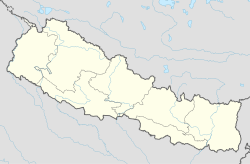| Rana Ujeshwori Bhagwati temple | |
|---|---|
रण उजेश्वरी भगवती मन्दिर | |
 Rana Ujeshwori Bhagwati temple | |
| Religion | |
| Affiliation | Hinduism |
| District | Palpa |
| Deity | Bhagwati |
| Festivals | Dashain |
| Location | |
| Location | Bhairabsthan |
| Country | Nepal |
 | |
| Geographic coordinates | 27°52′05″N83°32′38″E / 27.868°N 83.544°E |
The Rana Ujeshwori Bhagwati temple is located inside the Tansen Durbar square in Palpa district of Nepal. The temple was built by Ujir Singh Thapa as an offering to Goddess Bhagwati on the occasion of victory by Nepal Army over British Raj in Anglo-Nepali War (1872 BS). [1] [2]
Contents
The temple was destroyed by the earthquake of 1990 BS [3] and was renovated by Pratap Shamsher Jung Bahadur Rana. [4]
